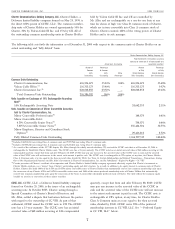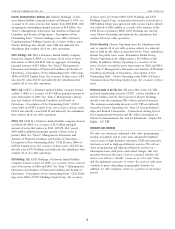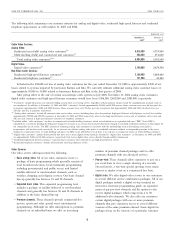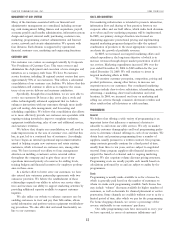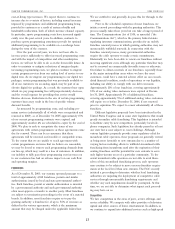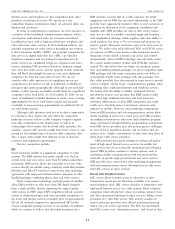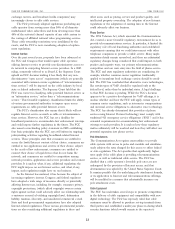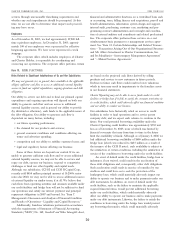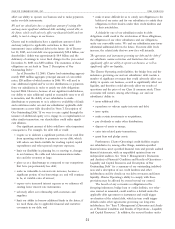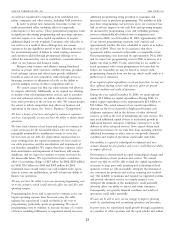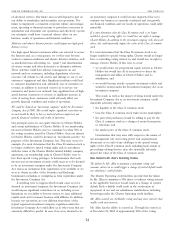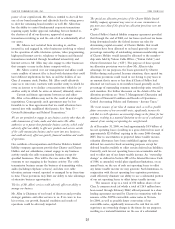Charter 2005 Annual Report Download - page 26
Download and view the complete annual report
Please find page 26 of the 2005 Charter annual report below. You can navigate through the pages in the report by either clicking on the pages listed below, or by using the keyword search tool below to find specific information within the annual report.
CHARTER COMMUNICATIONS, INC. 2005 FORM 10-K
Broadcast Television from operating advantages not available to franchised cable
Cable television has long competed with broadcast television, systems, including fewer regulatory burdens and no requirement
which consists of television signals that the viewer is able to to service low density or economically depressed communities.
receive without charge using an ‘‘off-air’’ antenna. The extent of Exemption from regulation may provide a competitive advan-
such competition is dependent upon the quality and quantity of tage to certain of our current and potential competitors.
broadcast signals available through ‘‘off-air’’ reception compared Wireless Distribution
to the services provided by the local cable system. Traditionally, Cable systems also compete with wireless program distribution
cable television has provided a higher picture quality and more services such as multi-channel multipoint distribution systems or
channel offerings than broadcast television. However, the recent ‘‘wireless cable,’’ known as MMDS, which uses low-power
licensing of digital spectrum by the FCC will provide traditional microwave frequencies to transmit television programming
broadcasters with the ability to deliver high definition television over-the-air to paying customers. MMDS services, however,
pictures and multiple digital-quality program streams, as well as require unobstructed ‘‘line of sight’’ transmission paths and
advanced digital services such as subscription video and data MMDS ventures have been quite limited to date.
transmission. The FCC has completed its auction of Multichannel Video
Traditional Overbuilds Distribution & Data Service (‘‘MVDDS’’) licenses. MVDDS is a
Cable systems are operated under non-exclusive franchises new terrestrial video and data fixed wireless service that the
granted by local authorities. More than one cable system may FCC hopes will spur competition in the cable and DBS
legally be built in the same area. It is possible that a franchising industries.
authority might grant a second franchise to another cable
REGULATION AND LEGISLATION
operator and that such a franchise might contain terms and
conditions more favorable than those afforded us. In addition, The following summary addresses the key regulatory and
entities willing to establish an open video system, under which legislative developments affecting the cable industry. Cable
they offer unaffiliated programmers non-discriminatory access to system operations are extensively regulated by the FCC, some
a portion of the system’s cable system, may be able to avoid state governments and most local governments. A failure to
local franchising requirements. Well financed businesses from comply with these regulations could subject us to substantial
outside the cable industry, such as public utilities that already penalties. Our business can be dramatically impacted by changes
possess fiber optic and other transmission lines in the areas they to the existing regulatory framework, whether triggered by
serve, may over time become competitors. There are a number legislative, administrative, or judicial rulings. Congress and the
of cities that have constructed their own cable systems, in a FCC have expressed a particular interest in increasing competi-
manner similar to city-provided utility services. There also has tion in the communications field generally and in the cable
been interest in traditional overbuilds by private companies. television field specifically. The 1996 Telecom Act, which
Constructing a competing cable system is a capital intensive amended the Communications Act, altered the regulatory
process which involves a high degree of risk. We believe that in structure governing the nation’s communications providers. It
order to be successful, a competitor’s overbuild would need to removed barriers to competition in both the cable television
be able to serve the homes and businesses in the overbuilt area market and the local telephone market. At the same time, the
on a more cost-effective basis than we can. Any such overbuild FCC has pursued spectrum licensing options designed to
operation would require either significant access to capital or increase competition to the cable industry by wireless mul-
access to facilities already in place that are capable of delivering tichannel video programming distributors. We could be materi-
cable television programming. ally disadvantaged in the future if we are subject to new
As of December 31, 2005, we are aware of overbuild regulations that do not equally impact our key competitors.
situations impacting approximately 6% of our total homes Congress and the FCC have frequently revisited the subject
passed and potential overbuild situations in areas servicing of communications regulation, and they are likely to do so in
approximately an additional 4% of our total homes passed. the future. For example, under the Communications Act, the
Additional overbuild situations may occur in other systems. FCC can establish rules ‘‘necessary to provide diversity of
information sources’’ when cable systems with at least 36
Private Cable
channels are available to 70% of U.S. homes and 70% of those
Additional competition is posed by satellite master antenna
homes subscribe to cable service. The FCC has concluded that
television systems, or SMATV systems, serving multiple dwelling
cable systems with at least 36 channels are available to 70% of
units, or MDUs, such as condominiums, apartment complexes,
U.S. homes and is now exploring whether the second part of
and private residential communities. These private cable systems
the test has been met. In addition, franchise agreements with
may enter into exclusive agreements with such MDUs, which
local governments must be periodically renewed, and new
may preclude operators of franchise systems from serving
operating terms may be imposed. Future legislative, regulatory,
residents of such private complexes. Private cable systems can
or judicial changes could adversely affect our operations. We
offer both improved reception of local television stations and
many of the same satellite-delivered program services that are
offered by cable systems. SMATV systems currently benefit
16



